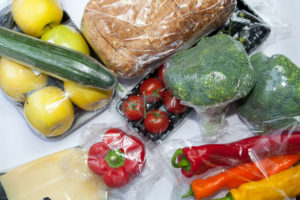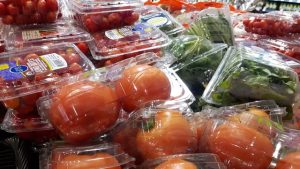Canada is drowning in plastic waste — and recycling won’t save us
For the first 50 years after plastic was invented, the idea of only using the long-lasting material once was blasphemous, an affront to values of frugality honed over years of war and economic strife.
Then, in the late 1950s, the plastics industry launched a massive marketing campaign — and single-use plastic was born.
“The happy day has arrived when nobody any longer considers plastic packages too good to throw away,” Lloyd Stouffer said at the 1963 U.S. National Plastic Conference. Stouffer was a U.S. plastics marketing guru and the man who, in 1956, first pitched the idea that a virtually indestructible material — plastic — should be sold as disposable.
Since then, about 8.3 billion tonnes have been produced; most has been thrown out. Landfills are stuffed. Oceans and the animals in them are choked. Plastic particles are even showing up in human placentas, with unknown health impacts.
Plastic is everywhere: Manhattan, the Marianas Trench, even Mars.
Faced with this ecological crisis, dozens of Canadian municipalities and provinces have joined a growing global movement against plastic pollution. They have introduced bans and crafted new waste management legislation to try to control the problem.
Recently, the federal government jumped in, announcing plans for a national waste strategy that would list plastics as toxic under Schedule 1 of the Canadian Environmental Protection Act (CEPA) and a ban on some single-use plastics. Most importantly, the plan calls for a new “circular economy” that would rely on massively scaling up existing recycling facilities and still-nascent recycling technologies to keep disposable plastic ubiquitous in our daily lives.
But can recycling really save us?
“Any material in the world can be recycled — if you separate it, prepare it and pay enough money to put it through the (recycling) process. The question is, is there a market for it? That’s what drives recycling,” says Samantha MacBride, an expert in solid waste management and a professor of urban environmental studies at the Marxe School of Public Affairs at Baruch College of CUNY in New York City.
“It’s a great industry — it provides jobs, it makes use of what’s around — but it doesn’t have anything directly to do with improving the environment.”
Canadians dispose of about 3.3 million tonnes of plastic each year, according to a 2019 study commissioned by Environment and Climate Change Canada (ECCC), almost half of which is packaging. Well over three-quarters currently goes to landfills, a small proportion is incinerated and about one per cent ends up directly in the environment.
Only nine per cent — or 305,000 tonnes — is recycled, the 2019 study found.
That’s no surprise. Low oil prices make it difficult for plastic recyclers, who must invest in expensive sorting and processing facilities, to compete against already established petrochemical manufacturers, whose facilities are well integrated with the oil and gas industry. It’s cheaper to make plastic from so-called “virgin oil” and put the waste in landfills than it is to recycle old plastics into new products.
Oil and natural gas producers are betting heavily on continued growth in virgin plastic production, with the industry expected to soon account for between 45 and 95 per cent of global growth in demand for oil and natural gas, according to a September report by the Carbon Tracker Initiative.
How tech barriers stand in the way of recycling
Beyond economics, recycled plastic production is hindered by available technology. Mechanical recycling, a method where plastics are sorted and shredded before being melted down into pellets to make new products, is by far the most common form of recycling in Canada. For the process to be effective, however, the stream of plastics entering the recycling facility needs to be clean and well sorted — a requirement that is difficult to meet.
The variety of plastics on the market adds to the challenge: There are over a dozen types, each with different melting points and manufacturing requirements. Many are also incorporated into different parts of the same consumer product, which makes sorting difficult or impossible.
Dyes and other (sometimes poisonous) additives, like plasticizers and fire retardants, further complicate the process and diminish the recycled product’s final quality. With the exception of easy-to-sort, single-use bottles like those used for water or pop, few mechanically recycled plastics can be reused to hold food, according to a December 2020 report by Greenpeace Canada.
There is some promise in a suite of new recycling technologies, collectively called “advanced” or “chemical” recycling, which break plastics down into their molecular components so they can be remade into like-new products. Proponents are optimistic the new methods will be cleaner and more efficient, but observers have doubts. They also face substantial market challenges in Canada, pushing some to advance business ventures in Europe, where regulations forcing plastic manufacturers to use recycled plastic in their products make investments in the technology financially viable. Similar regulations are included in the federal government’s planned plastic regulations, first announced in October.
These technical and market limitations mean Canada’s existing recycling industry focuses almost exclusively on four easy-to-recycle plastics:
- polyethylene terephthalate (PET), common in carpets, cups and water bottles
- high-density polyethylene (HDPE), common in milk jugs, outdoor furniture and pipes
- low-density polyethylene (LDPE), common in bread and trash bags
- polypropylene (PP), common in straws, auto parts and juice bottles
Other plastic products — from Spandex to vinyl siding — are mostly landfilled.
And when it comes to market share, producers of recycled plastics remain small players. Sales of recycled plastics in Canada were worth about $350 million in 2016 — 30 times less than sales of plastic made from virgin oil, the 2019 ECCC study noted.
Shifting responsibility
Regardless, the claim that recycling is the panacea for plastic pollution has been promoted for decades by the plastics industry and its allies, says Max Liboiron, professor of geography at Memorial University and director of the CLEAR laboratory on plastic pollution.
“Recycling was formalized and launched in 1970 on Earth Day … by the Container Corporation of America, which had sponsored a design competition for the now-universal recycling symbol,” explains Liboiron. Industry’s hope was that recycling would assuage growing concerns among Americans (and Canadians) about the environmental and aesthetic impact of pollution, including from disposable plastic.
Global plastic production skyrocketed after 1950, increasing more than tenfold to reach about 35 million tonnes by 1970. Very little of it was recycled, and plastic soon infiltrated every facet of society, from grocery stores to hospitals.



